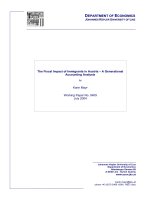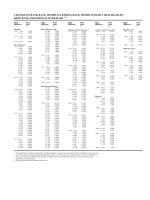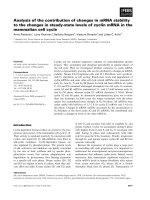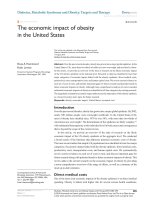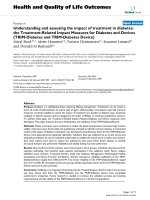the impact of changes in bank ownership structure around the world
Bạn đang xem bản rút gọn của tài liệu. Xem và tải ngay bản đầy đủ của tài liệu tại đây (764.11 KB, 153 trang )
THE IMPACT OF CHANGES IN BANK OWNERSHIP STRUCTURE
AROUND THE WORLD
DISSERTATION
Presented in Partial Fulfillment of the Requirements for the
Degree Doctor of Philosophy in the Graduate School of The
Ohio State University
By
Alvaro G. Taboada, CFA, MBA
The Ohio State University
2008
Dissertation Committee: Approved by
Professor G. Andrew Karolyi, Advisor _______________________
Advisor
Professor Isil Erel Graduate Program in
Business Administration
Professor Kewei Hou
Professor Ingrid Werner
ii
ABSTRACT
Large scale bank privatizations over the last ten years have resulted in vast
changes in the ownership structure of banking sectors throughout the world. This
dissertation explores both the macro and micro level effects of these changes in bank
ownership structure. The first essay explores how changes in bank ownership structure
affect capital allocation efficiency within countries. I find that the decline in government
ownership of banks by itself does not have any impact on capital allocation efficiency;
rather, what matters is whether foreigners or large domestic shareholders acquire the
stakes relinquished by the government. Increases in domestic blockholder ownership of
banks adversely affect the allocation of capital through increased lending activity to less
productive industries, while increased foreign presence improves capital allocation
efficiency by directing credit to more productive sectors and to industries that rely more
on external financing.
In the second essay I explore how changes in bank ownership structure affect the
performance of individual banks and the banking sector. The primary contribution of this
essay is to examine the role of large domestic blockholders on bank performance. I find
that increases in large domestic blockholder ownership of banks are associated with poor
subsequent performance in terms of asset quality, profitability, and bank value. In
iii
contrast, increases in foreign ownership lead to improvements in profitability and bank
value, consistent with prior findings. Government ownership of banks continues to affect
bank performance adversely. Finally, increased presence of large domestic blockholders
in the banking sector has a positive spillover effect on banking sector asset quality and
profitability, while increased foreign presence is no longer associated with improvements
in the competitiveness of the banking sector, contrary to what prior studies have found.
iv
To my parents, Dr. Alvaro J. Taboada and Esther M. Taboada
v
ACKNOWLEDGMENTS
I would like to thank my committee members G. Andrew Karolyi (Committee
Chair), Isil Erel, Kewei Hou, and Ingrid Werner for their invaluable comments and
continued encouragement and support throughout this process. I am also deeply indebted
to René Stulz, Roger Loh, my colleagues, and all seminar participants at The Ohio State
University for their insightful and helpful comments and suggestions.
Finally, special thanks to José F. Alvarez at Banco Sabadell, and to Mitch Gouss
at Bureau van Dijk, who provided access to key data used in this dissertation.
vi
VITA
October 15, 1973…………………………………….Born in León, Nicaragua
1995…Bachelor of Business Administration, Florida International University, Miami, FL
1997……Master of Business Administration, University of Notre Dame, Notre Dame, IN
1997-2003… International Bank Examiner, Federal Reserve Bank of Atlanta, Miami, FL
FIELDS OF STUDY
Major Field: Business Administration
Concentration: Finance
vii
TABLE OF CONTENTS
ABSTRACT ii
ACKNOWLEDGMENTS v
VITA vi
LIST OF TABLES x
LIST OF FIGURES xii
CHAPTER 1: INTRODUCTION 1
CHAPTER 2: THE IMPACT OF CHANGES IN BANK OWNERSHIP STRUCTURE
ON THE ALLOCATION OF CAPITAL 6
2.1. Introduction 6
2.2. Literature Review 10
2.2.1. Empirical Evidence on Government Ownership of Banks 10
2.2.2. Empirical Evidence on Foreign Ownership of Banks 13
2.2.3. Contribution of this Study 16
2.3. Data and Methodology 17
2.4. Changes in Bank Ownership Structure 25
2.4.1. Current State of Bank Ownership Structure around the World 25
2.4.2. Changes in Bank Ownership Structure and Country Characteristics 29
2.5. Bank Ownership Structure and the Allocation of Credit 32
2.5.1. Changes in Bank Ownership Structure & Credit Growth 32
viii
2.5.2. Changes in Bank Ownership Structure and Credit Allocation Efficiency 34
2.5.3. Addressing Endogeneity Concerns 37
2.5.4. Impact of Changes in DB – Testing Alternative Hypotheses 39
2.5.5. Credit Growth to Industries with High Dependence on External Financing 42
2.6. Bank Ownership Structure and the Allocation of Capital 46
2.6.1. Additional Robustness Tests 51
2.7. Conclusion 52
CHAPTER 3: DOES THE GROWING PRESENCE OF LARGE DOMESTIC
BLOCKHOLDERS AROUND THE WORLD AFFECT BANK PERFORMANCE? 54
3.1. Introduction 54
3.2. Literature Review 58
3.2.1. Empirical Evidence on State Ownership of Banks 58
3.2.2. Empirical Evidence on Foreign Ownership of Banks 60
3.2.3. Contribution of this Study 62
3.3. Data and Methodology 63
3.3.1. Bank Performance Measures 67
3.4. Bank Ownership and Bank Performance 68
3.4.1. Changes in Bank Ownership and Bank Performance 69
3.4.2. Bank Ownership and Bank Performance – Q measure of performance 74
3.5. Spillover Effects of Changes in Bank Ownership Structure 77
3.6. Conclusion 82
CHAPTER 4: CONCLUSION 84
LIST OF REFERENCES 87
APPENDIX A CREDIT DATA SOURCES 93
APPENDIX B DESCRIPTION OF INDUSTRIES FOR CREDIT DATA 98
ix
APPENDIX C EXAMPLE OF OWNERSHIP VARIABLE CONSTRUCTION 99
APPENDIX D TABLES 101
APPENDIX E FIGURES 141
x
LIST OF TA BLES
Table 1: Summary statistics 101
Table 2: Ownership of banks around the world: 1995, 2000, and 2005 103
Table 3: Changes in bank ownership structure between 1995 and 2005 107
Table 4: Changes in bank ownership and country characteristics 109
Table 5: Which countries experienced more changes in bank ownership structure? 110
Table 6: Effect of changes in bank ownership structure on industry credit growth 114
Table 7: Effect of changes in bank ownership structure on the allocation of credit 115
Table 8: Regressions using instrumental variables for changes in bank ownership 117
Table 9: Testing the impact of domestic blockholder ownership of banks 119
Table 10: Credit growth in industries by extent of dependence on external finance . 121
Table 11: Descriptive statistics - measures of capital allocation efficiency 122
Table 12: Impact of changes in bank ownership structure on capital allocation-
instrumental variables approach 124
Table 13: Regressions using new measure of capital allocation efficiency 127
Table 14: Descriptive statistics - banks with available data by year 128
Table 15: Impact of changes in bank control on bank performance –
Heckman Model 129
Table 16: Changes in control and bank value 133
xi
Table 17: Spillover effects of changes in bank ownership structure – Instrumental
Variable (IV) approach 136
xii
LIST OF FIGURES
Figure 1: Changes in bank ownership structure 141
1
CHAPTER 1:
INTRODUCTION
A new wave of bank privatizations in the past decade has significantly changed
the ownership structure of banking systems around the world. These privatizations were
perhaps in part driven by the well documented findings about the poor performance of
government-owned banks (Berger, Clarke, Cull, Klapper, and Udell, 2005; Mian, 2006b;
Micco, Panizza, and Yañez, 2004), as well as by the evidence pointing to the detrimental
role of government ownership of banks on financial and economic development (Barth,
Caprio, and Levine, 2004; Galindo and Micco, 2004; La Porta, Lopez-de-Silanes, and
Shleifer, 2002a). While the impact of bank privatizations on bank performance has been
well documented in the literature, as summarized in various papers (Clarke, Cull, and
Shirley, 2005; Megginson, 2005), there is little evidence on the broader (macro level)
implications of these changes in bank ownership structure. In addition, the role of large
domestic blockholders has been ignored in most studies of bank ownership
1
(Claessens,
Demirgüç-Kunt, and Huizinga, 2001; Demirgüç-Kunt and Huizinga, 1999; Micco, et al.,
2004).
1
Caprio, Laeven, and Levine (2003) study the link between governance and bank valuation, and find that
larger cash flow rights by the controlling owners boost valuation.
2
This dissertation contributes to the literature first by documenting the vast
changes in bank ownership structure over the past ten years - using a hand-collected
database on the ownership structure of the largest (top ten) banks in 90 countries - and by
examining two aspects of these changes that have not been adequately explored thus far.
In CHAPTER 2, I explore some macro level implications of the changes in bank
ownership structure. In particular, I examine how changes in bank ownership structure
affect capital allocation efficiency. CHAPTER 3 explores how changes in bank
ownership affect the performance of individual banks and the banking sector, with
particular attention paid to the role of large domestic blockholders.
Throughout the world, banks continue to play an important role in the allocation
of capital, or more specifically, in the way credit is distributed. Given the importance of
allocating capital efficiently, which has been cited as a reason why financial development
is associated with economic growth (Beck, Levine, and Loayza, 2000b; Goldsmith, 1969;
Greenwood and Jovanovic, 1990; McKinnon, 1973; Shaw, 1973), coupled with the vast
changes in bank ownership structure over the past decade, CHAPTER 2 explores how
these changes affect the efficiency of capital allocation. I argue that if credit is allocated
efficiently, more credit should be allocated to more productive industries (those that
contribute more to GDP). I explore these questions using data on outstanding credit by
industry – collected from various Central Banks and banking regulatory authorities – and
data on industry value added (i.e. an industry’s contribution to GDP).
The large scale bank privatizations that have occurred over the past decade should
in theory reduce the politically motivated lending practices of government-owned banks,
which should translate into better capital allocation. Surprisingly, I find that the decline
3
in government ownership of banks by itself does not affect capital allocation efficiency.
What matters is who takes over the ownership stakes relinquished by the government.
When large domestic blockholders increase their stakes in banks, capital allocation
efficiency is hampered; in contrast, increased foreign presence in the banking sector has
positive effects on capital allocation efficiency.
Increased domestic blockholder (DB) presence adversely affects capital allocation
efficiency. Increases in DB are associated with increased lending to less productive
economic sectors and to industries that are not dependent on external finance, suggesting
a misallocation of funds by domestic blockholder-controlled banks. These findings are
consistent with the looting view, a pessimistic assessment of related lending practices by
banks (La Porta, Lopez-De-Silanes, and Zamarripa, 2003). Large domestic blockholders
of banks (e.g. local companies, wealthy individuals) typically have substantial interests in
nonfinancial firms as well; banks controlled by these domestic blockholders usually
direct a significant portion of their lending activities to related parties (e.g. firms
controlled by relatives), even when these firms are inefficient. This behavior, observed
primarily in developing countries with poor governance (La Porta, et al., 2003; Laeven,
2001), could thus adversely affect capital allocation efficiency.
In contrast to the adverse impact of increased domestic blockholder ownership of
banks, increased foreign presence in the banking sector improves capital allocation
efficiency. Countries experiencing increases in foreign presence in the banking sector
increase lending to more productive industries, and to those that rely more on external
finance. This new result adds support to the findings of Giannetti and Ongena (2007) who
document that in Eastern European countries, foreign banks improve capital allocation by
4
mitigating the related lending problems. Foreign banks, which have been shown to
outperform local banks, primarily in developing countries (Claessens, et al., 2001;
Demirgüç-Kunt and Detragiache, 2005; Micco, et al., 2004), are more likely to pursue
profit maximizing opportunities than government or domestic blockholder-controlled
banks, which may have ulterior motives. These foreign banks will thus be more likely to
direct investment to those firms or industries with better prospects. This will lead to the
observed positive impact of increased foreign presence on capital allocation efficiency.
CHAPTER 3 then examines the impact of changes in bank ownership structure on
individual bank performance, with particular attention paid to the role of domestic
blockholders. Large domestic blockholders may significantly affect bank performance,
just as they have been shown to affect firm value in the corporate finance literature.
There are different hypotheses that have emerged in the corporate finance literature.
According to the incentive-based view (Shleifer and Vishny, 1997), shareholders with
large cash flow ownership have an incentive to closely monitor a firm’s performance,
potentially mitigating the principal-agent problems that exist between managers and
shareholders (Jensen and Meckling, 1976). In line with this view, several studies have
shown a positive correlation between firm value and cash flow ownership of large
shareholders (Claessens, Djankov, Fan, and Lang, 2002; La Porta, Lopez-de-Silanes,
Shleifer, and Vishny, 2002b). In contrast, large blockholders may negatively affect firm
performance if they pursue their own interests at the expense of other minority
shareholders (Shleifer and Vishny, 1997). Consistent with this entrenchment-based view,
formalized by Stulz (1988), evidence has shown that firm value falls when control rights
exceed cash flow rights of large shareholders (Claessens, et al. 2002).
5
I find evidence consistent with the entrenchment-based view. Increased domestic
blockholder ownership of banks is associated with poor subsequent performance. In
particular, I find that banks changing from government to domestic blockholder control
perform poorly in terms of asset quality and profitability. In addition, these changes in
control have a detrimental impact on bank value. This evidence suggests that domestic
blockholders may be acquiring stakes in banks to extract private benefits of control,
which results in poor bank performance. These findings are also consistent with the
looting view (La Porta, et al., 2003); these banks may be directing a significant portion of
their lending to related, yet inefficient companies, which hurts performance. Consistent
with prior findings, I also find a positive impact of increases in foreign ownership of
banks on profitability and operational efficiency. I also confirm prior findings associated
with the poor performance of government-owned banks. Furthermore, increases in
domestic blockholder ownership of banks appear to improve the asset quality and
profitability of the banking sector. Contrary to prior findings, foreign presence does not
improve the competitiveness of the domestic banking sector.
6
CHAPTER 2:
THE IMPACT OF CHANGES IN BANK OWNERSHIP STRUCTURE ON THE
ALLOCATION OF CAPITAL
2.1. Introduction
Government ownership of banks has been consistently declining since 1970. This
pattern has accelerated over the past ten years. La Porta, Lopez-de-Silanes, and Shleifer
(2002a) document that government ownership of banks was still prevalent around the
world in 1995. Since then, the average government ownership of banks (GB) has
declined significantly, dropping to 21% as of 2005. Bank privatizations in the former
socialist countries, including Romania, Bulgaria, Hungary, and Poland, have led the way
in the latest wave of bank privatizations around the world. While privatizations in these
countries have led to an increase in foreign ownership of banks (FB), other countries such
as Belgium, Colombia, France, Norway, and Taiwan have experienced significant
increases in domestic blockholder ownership of banks (DB). Although the impact of
privatization on bank performance has received a lot of attention recently, the
consequences of the resulting changes in bank ownership
7
structure on capital allocation efficiency in the corporate sector have yet to be explored.
2
Specifically, no study has examined whether there is a link between a country’s banking
sector ownership structure and capital allocation efficiency.
3
In addition, the role of large
domestic blockholders has been ignored in most studies of bank ownership (Claessens, et
al., 2001; Demirgüç-Kunt and Huizinga, 1999; Micco, et al., 2004).
4
Allocating capital efficiently has been cited as a reason why financial
development is associated with economic growth (Beck, et al., 2000b; Goldsmith, 1969;
Greenwood and Jovanovic, 1990; McKinnon, 1973; Shaw, 1973). Banks play an
important role in the allocation of capital, or more specifically, in the way credit is
distributed. Companies in many countries - particularly in those with less developed
equity markets and weak shareholder protection - continue to rely on bank lending for
financing (Booth, Aivazian, Demirgüç-Kunt, and Maksimovic, 2001; Giannetti, 2003).
With this in mind, this essay contributes to the existing literature by examining whether
and how the changes in bank ownership structure (including, in particular, the increased
presence of domestic blockholders) around the world affect capital allocation efficiency.
I will argue that if credit is allocated efficiently, more credit should be provided to
industries that contribute more to GDP (generate more value added). In some robustness
tests, I also use Wurgler’s (2000) definition of capital allocation efficiency as the extent
to which investment increases in growing industries and decreases in declining industries.
2
Clarke, Cull, and Shirley (2005), and Megginson (2005) provide good summaries of the existing literature
on the effects of bank privatization on bank performance.
3
Beck and Levine (2002) explore whether having a bank or market-based system matters for capital
allocation efficiency. They do not find any evidence that this matters.
4
Caprio, Laeven, and Levine (2003) study the link between governance and bank valuation, and find that
larger cash flow rights by the controlling owners boost valuation.
8
Government ownership of banks has been associated with subpar bank
performance (Dinç, 2005; Micco, Panizza, and Yañez, 2006; Sapienza, 2004), in line
with the political view, which argues that government control of financial institutions
politicizes resource allocation for the sake of advancing certain political agendas (e.g.
obtaining votes, bribing office holders), and, by pursuing such objectives, economic
efficiency is hampered (Kornai, 1979; Shleifer and Vishny, 1994). Such behavior by
government-owned banks should, in turn, hurt capital allocation, particularly in countries
with a large government presence in the banking sector; yet, this has not been explored in
the literature thus far.
5
I examine whether the large declines in government ownership of
banks improve the efficiency of capital allocation. Bank privatizations should reduce the
politically-motivated lending practices that adversely affect capital allocation.
Surprisingly, I find that the decline in government ownership of banks by itself does not
affect capital allocation efficiency. What matters is who takes over the ownership stakes
relinquished by the government. When large domestic blockholders increase their stakes
in banks, capital allocation efficiency is hampered; in contrast, increased foreign presence
in the banking sector has positive effects on capital allocation efficiency.
This study further contributes to the literature by examining how the increased
presence of domestic blockholders (DB) in the banking sector affects capital allocation.
Increased domestic blockholder presence adversely affects capital allocation efficiency.
Increases in DB are associated with increased lending to less productive economic sectors
and to industries that are not dependent on external finance, suggesting a misallocation of
5
Wurgler (2000) documents that capital allocation efficiency is negatively correlated with the extent of
government presence in the economy. He does not look at government presence in the banking industry,
however.
9
funds by domestic blockholder-controlled banks. These findings are consistent with the
looting view, a pessimistic assessment of related lending practices by banks (La Porta, et
al., 2003). Large domestic blockholders of banks (e.g. local companies, wealthy
individuals) typically have substantial interests in nonfinancial firms as well; banks
controlled by these domestic blockholders usually direct a significant portion of their
lending activities to related parties (e.g. firms controlled by relatives), even when these
firms are inefficient. This behavior, observed primarily in developing countries with
poor governance (La Porta, et al., 2003; Laeven, 2001), could adversely affect capital
allocation efficiency.
In contrast to the adverse impact of increased domestic blockholder ownership of
banks, increased foreign presence in the banking sector improves capital allocation
efficiency. Countries experiencing increases in FB increase lending to more productive
industries, and to those that rely more on external finance. This new result adds support
to the findings of Giannetti and Ongena (2007) who document that in Eastern European
countries, foreign banks improve capital allocation by mitigating the related lending
problems. Foreign banks, which have been shown to outperform local banks, primarily
in developing countries (Claessens, et al., 2001; Demirgüç-Kunt and Detragiache, 2005;
Micco, et al., 2004), are more likely to pursue profit maximizing opportunities than
government or domestic blockholder-controlled banks, which may have ulterior motives.
These foreign banks will thus be more likely to direct investment to those firms or
industries with better prospects. This will lead to the observed positive impact of
increased foreign presence on capital allocation efficiency. This finding is also consistent
with the interest group theory of financial development (Rajan and Zingales, 2003).
10
Foreign bank presence is indicative of a more open financial system in which there is
greater competition. With increased competition, banks that rely on relationship-based
lending (incumbent financiers) will have less flexibility to pursue detrimental activities
(e.g. lending to inefficient, but related firms). This will in turn improve capital allocation
efficiency.
The rest of the chapter is organized as follows. Section 2.2 expands on the
discussion on the existing literature on bank ownership. Section 2.3 describes the data
and methodology used in the study. Section 2.4 describes the current state of bank
ownership structure around the world and explores the characteristics of countries that
have experienced the most drastic changes in bank ownership structure. Section 2.5
explores the link between bank ownership structure and the allocation of bank credit,
Section 2.6 examines the impact of changes in bank ownership structure on a broader
measure of capital allocation efficiency, and Section 2.7 concludes.
2.2. Literature Review
2.2.1. Empirical Evidence on Government Ownership of Banks
The existing literature on government ownership of banks has documented that
this form of ownership was pervasive around the world as of 1995, is more prevalent in
poorer countries (Barth, Caprio, and Levine, 1999), and in countries with more
interventionist and less efficient governments and less secure property rights (La Porta, et
al., 2002a). The bulk of the evidence supports the political view of government
11
ownership of banks.
6
Consistent with this view, several papers document that
government ownership of banks inhibits financial development and economic growth
(Barth, et al., 2004; Galindo and Micco, 2004; La Porta, et al., 2002a). La Porta et al.
(2002a) show that higher government ownership of banks in 1970 is associated with
slower subsequent financial development and lower economic growth. Barth et al.
(2004) examine the relationship between state ownership and banking sector
development measures. They find that government ownership of banks is negatively
related to favorable banking outcomes, and positively related with corruption. Micco,
Panizza, and Yañez (2006), Sapienza (2004), and Dinç (2005) provide further support for
the political view. Micco et al. (2006) find that the difference in public and private
banks’ performance widens during election years, supporting the hypothesis that political
considerations drive these results. Sapienza (2004) finds that lending behavior of state-
owned banks in Italy is affected by electoral results of the party affiliated with the bank.
In addition, Dinç (2005) shows that government-owned banks in emerging markets
significantly increase their lending in election years relative to private banks. The author
interprets this as evidence that politicians can reward their allies and punish their
opponents through their influence on government-owned banks. Megginson (2005) has a
more complete review of this literature.
Another well-documented finding is the poor performance of state-owned banks
relative to their domestic or foreign-owned counterparts (Berger, et al., 2005; Mian,
2006b; Micco, et al., 2004). Berger et al. (2005) use data from Argentina in the 1990s to
analyze the static, selection, and dynamic effects of domestic, foreign, and state
6
This view argues that government-owned institutions pursue politically motivated objectives.
12
ownership on bank performance. They find that state-owned banks have poor long-term
performance and that those banks undergoing privatization have poor performance
beforehand, and dramatically improve their performance after privatization. Mian
(2006b) studies 1,600 banks in 100 emerging markets and documents that government
banks perform poorly and only survive due to government support. Micco et al. (2004)
examine the relationship between bank ownership and bank performance for banks in 119
countries. They find that in developing countries, state-owned banks have lower
profitability, higher costs, higher employment ratios, and poorer asset quality than their
domestic counterparts. With the exception of state-owned banks having higher costs
than their domestic counterparts, they do not find evidence of significant differences
between state and domestic private banks’ performance in industrial countries. Cornett,
Guo, Khaksari, and Tehranian (2003) examine the differences in performance between
state-owned and private banks in 16 Far East countries between 1989 and 1998. They
also find that state-owned banks are significantly less profitable, have lower capital
ratios, greater credit risk, lower liquidity, and lower management efficiency.
The bulk of the evidence on state-ownership of banks suggests that it is associated
with poor bank performance and with negative economic outcomes. There is little
evidence supporting the more optimistic development view (Gerschenkron, 1962) of
government ownership of financial institutions, which argues that governments can play a
major role in the financial and economic development of countries in which economic
institutions are not sufficiently developed. The evidence supporting the political
motivations behind government-owned bank lending activities would support the
argument that government presence in the banking sector hinders capital allocation
13
efficiency.
7
With this in mind, this essay will test whether the vast reductions in
government ownership of banks have a positive effect on capital allocation efficiency.
2.2.2. Empirical Evidence on Foreign Ownership of Banks
While government ownership of banks is associated with poor bank performance,
the bulk of the literature documents a positive impact of foreign ownership on bank
performance. Barth et al. (2001) provide data on the share of banking assets held by
foreign-controlled banks in 91 countries as of 1998. Foreign-controlled banks hold
widely differing shares of assets across countries, but there is no obvious pattern based on
level of development. The data show that foreign-controlled banks hold the largest shares
in countries where the rule of law is well established, but where the financial sector is
less developed. There is evidence that banks’ size, efficiency and performance, and
home country restrictions play a role in determining which banks expand abroad. Several
studies find a positive correlation between bank size and internationalization (Focarelli
and Pozzolo, 2000; Grosse and Goldberg, 1991; Tschoegl, 1983). Clarke, et al. (2003)
provide a detailed summary of the evidence on foreign bank entry.
In terms of individual bank performance, Claessens et al. (2001) document that
foreign banks are more profitable than their domestic counterparts in developing
countries, but the opposite is true in developed markets. Demirgüç-Kunt and Huizinga
(1999) study banks in 80 countries over the 1988-1995 period and find that foreign banks
have higher margins and profits than domestic banks in developing countries, but the
opposite is true for industrial countries. Micco et al. (2004) also document that foreign
7
Wurgler (2000) provides indirect support for this, by finding that capital allocation efficiency is
negatively correlated with the extent of government presence in the economy.
